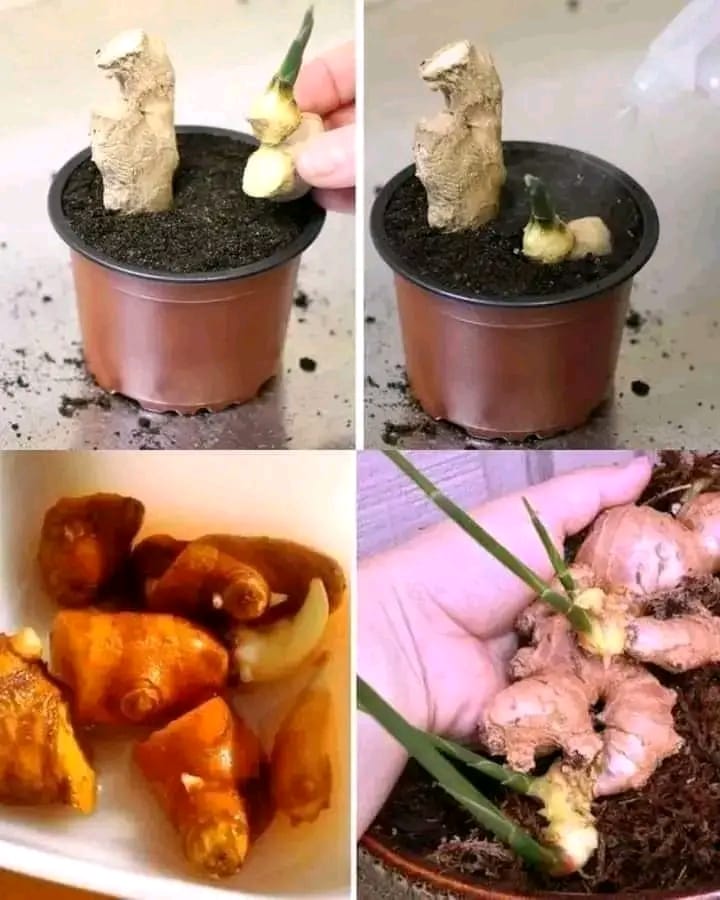Imagine plucking fresh, aromatic ginger straight from your home garden whenever you need it. Whether you’re looking to elevate your dishes, brew a soothing tea, or harness its medicinal benefits, ginger is an essential ingredient worth having on hand. Growing your own ginger at home is simpler than you might think. Follow this step-by-step guide to create an endless supply of ginger while enjoying the satisfaction of cultivating your own spice.
1. Selecting the Right Ginger
The journey to a thriving ginger plant begins with choosing the right rhizome. A ginger rhizome, commonly referred to as the root, is the part you’ll plant. When selecting ginger:
- Opt for a firm, plump rhizome with well-developed “eyes.” These small, budding points are the beginnings of future growth.
- Avoid shriveled, dry, or moldy rhizomes. Freshness is key for a successful start.
Pro Tip: Check your local farmer’s market or organic stores for the best-quality ginger.
2. Preparing the Rhizome
Preparation is crucial for kickstarting growth. Here’s how to get your rhizome ready for planting:
- Soak it overnight: Place the ginger in lukewarm water and leave it to soak for about 12 hours. This step hydrates the rhizome and encourages sprouting.
- Divide it into sections: Use a clean knife to cut the rhizome into smaller pieces, ensuring each section has at least one or two eyes. Allow the cut surfaces to dry for a few hours to prevent rot after planting.
3. Choosing a Container
Ginger thrives in the right environment, and your choice of container plays a significant role.
- Size matters: Use a wide, shallow container to accommodate the horizontal growth of the rhizomes. A pot that’s at least 12 inches wide and 8 inches deep works perfectly.
- Ensure it has drainage holes to prevent waterlogging, as ginger roots are prone to rot in soggy conditions.
- Fill the container with a well-draining potting mix rich in organic matter. Adding compost or aged manure boosts nutrients for healthy growth.
4. Planting and Watering
Now comes the fun part: planting your ginger. Follow these steps for successful planting:
- Place each rhizome section just below the soil surface, with the eyes pointing upwards.
- Space the sections about 6 inches apart to give them room to grow.
- Cover lightly with soil, ensuring they’re not buried too deep.
- Water thoroughly after planting, ensuring the soil is moist but not waterlogged.
Pro Tip: Use a spray bottle to gently mist the soil if you’re worried about overwatering.
5. Providing Ideal Conditions
Ginger is a tropical plant that thrives in warmth and humidity. To mimic its natural habitat:
- Maintain a temperature between 75-85°F (24-29°C). Place the container in a warm spot indoors or in a greenhouse if outdoor temperatures are too low.
- Increase humidity levels by using a humidity tray or misting the plant regularly.
Place the container in an area with indirect sunlight, such as a bright windowsill or shaded patio. Too much direct sunlight can scorch the leaves, while too little light may hinder growth.
6. Watering and Fertilizing
Proper care keeps your ginger plant healthy and productive.
- Keep the soil consistently moist by watering regularly. However, be careful not to overwater, as this can lead to root rot.
- During the growing season (spring to late summer), fertilize every 2-4 weeks with a balanced liquid fertilizer. Look for one that provides nitrogen, phosphorus, and potassium in equal measure.
Pro Tip: Add a layer of mulch around the base of the plant to retain soil moisture and suppress weeds.
7. Encouraging Blooms
Did you know ginger plants can produce beautiful flowers? While the rhizomes are the main attraction, the blooms are a bonus for avid gardeners.
- Provide ample sunlight, warmth, and humidity to encourage flowering.
- Avoid disturbing the plant unnecessarily. Frequent uprooting or repotting can stress the plant and delay blooming.
Patience is key, as it may take a year or more for the plant to produce flowers. But once it does, you’ll be rewarded with exotic, fragrant blooms that add a touch of tropical beauty to your space.
8. Harvesting and Enjoying
The moment you’ve been waiting for! After 8-10 months of growth, your ginger plant will be ready for harvest.
- Harvest ginger as needed by gently digging up the soil around the edges of the container and cutting off sections of the rhizome.
- If you want the plant to continue producing, leave some rhizomes intact and re-cover them with soil.
- Store any excess ginger in a cool, dry place or freeze it for longer shelf life.
Freshly harvested ginger offers unparalleled flavor and aroma. Use it in recipes, teas, or home remedies for a truly homegrown touch.
Conclusion: A Rewarding Journey
Growing your own ginger at home is not just a practical endeavor but also a deeply rewarding experience. By following these simple steps, you can enjoy a continuous supply of fresh, organic ginger for years to come. From cooking flavorful dishes to brewing comforting teas or even admiring its stunning blooms, homegrown ginger is a treasure that keeps giving.
So, what are you waiting for? Get started on your ginger-growing adventure today and transform your home into a tropical haven filled with nature’s spice!



